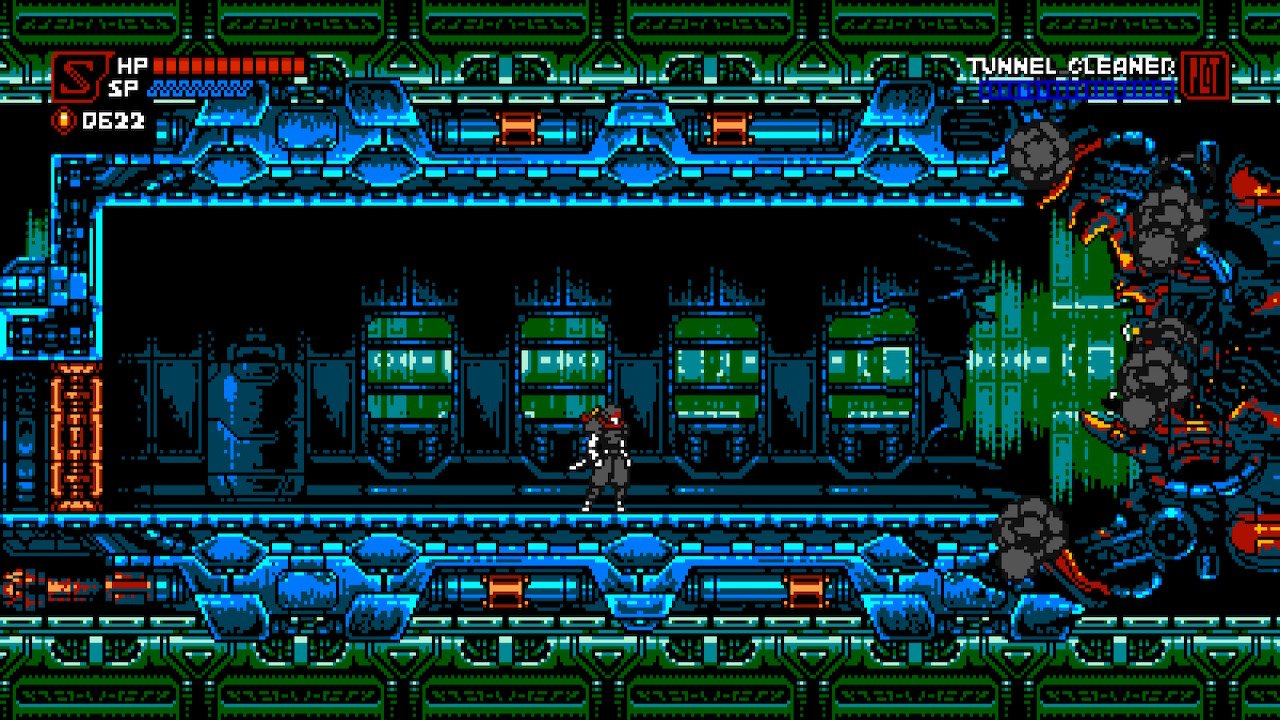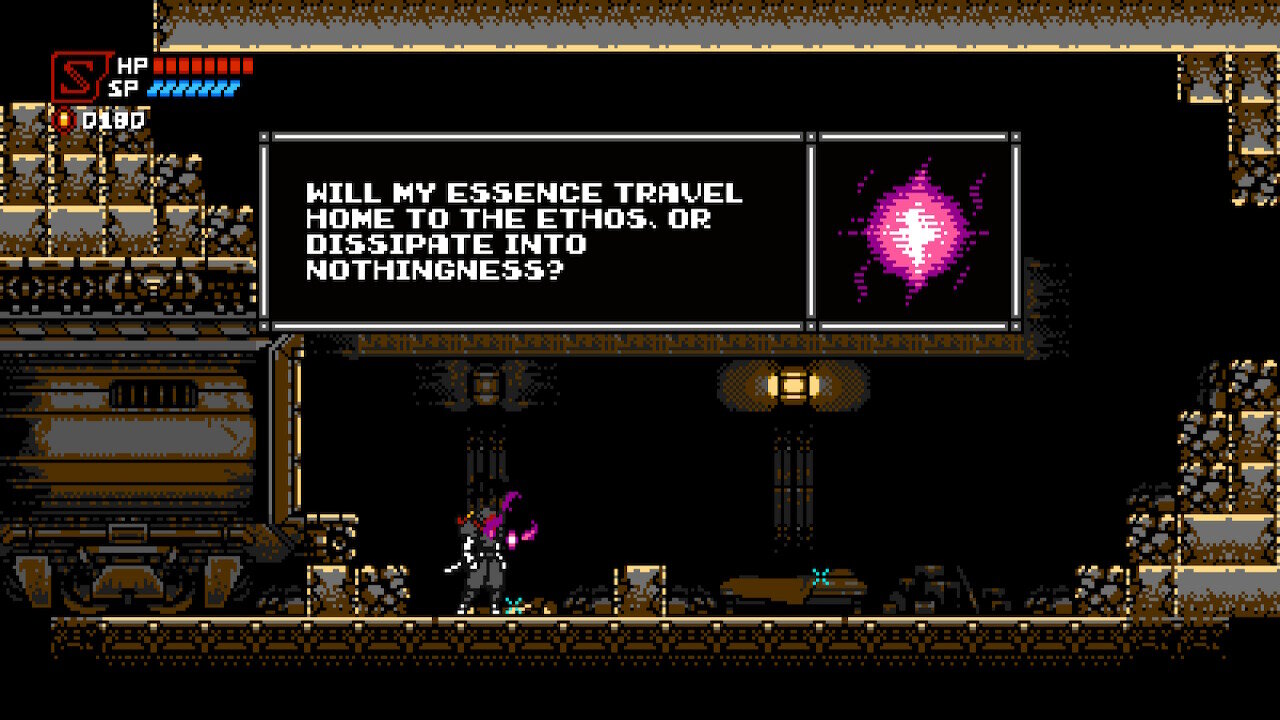Cyber Shadow review
When a legitimately great indie game is released for Switch, I try my best to scoop it up and play it right away, in the hopes that I can post a review fairly quickly. Since I’m doing this for fun though, I rarely manage to post my reviews in a timely fashion. Plus, let’s face it, I’m just not great at managing my free time. Anyway, the reason bring this up now is that Cyber Shadow is one of those great indie games.
From the moment I saw previews of Cyber Shadow, I knew I had to play it as soon as humanly possible. From developer Mechanical Head Games (Aarne “MekaSkull” Hunziker) and published by Yacht Club Games (the makers of Shovel Knight), this one seemed to have it all: classic ninja action gameplay, that retro pixel art aesthetic, the overall hardcore vibe of the NES. I preordered Cyber Shadow and started putting together this blog post well in advance of the game’s release. And then…well, I did start playing the game immediately. But I didn’t actually get around to writing a review for ages, so nothing got posted…until just now.
As a retro-stylized 2D action platformer indie game in the model of Ninja Gaiden, Cyber Shadow is sure to draw comparisons with Sabotage Studio’s The Messenger (2018). But if I’m being honest, I definitely enjoyed this game a whole lot more. Not that The Messenger is bad per se, but Cyber Shadow simply offers more of what I like in games of this particular style.
Since this is a ninja action game, one would expect that it is hard as nails. And that it is! The gameplay mostly to alternate between platforming segments and boss fights, with both providing a decent challenge. It’s not like each level is a breeze until you encounter a boss. It’s more like each platforming segment is a puzzle to be solved with the tools at your disposal. And then the boss fight is an extra combative puzzle to be solved under duress.
While the game is linear and level-based, it does have a great sense of progress and discovery. Your robot ninja protagonist acquires new skills along the way, which allows for the incremental introduction of techniques to not overwhelm the player, and also provides a sense of growth and mastery. It’s not exactly like a metroidvania, where a newly acquired skill allows you to further traverse the game world, but it kind of feels that way.
For example, the Sprint you unlock in Chapter 5 is pretty big game changer. If you press the attack button while sprinting, Shadow will perform a dash attack that flies a good distance in an instant. You can cover some long gaps with the dash attack, and it can be paired with a jump for added clearance. This dash attack is also invincible, so you can really tear through enemies using it. And while I’m not a speedrunning person, this move alone makes it feel like the game wants me to speedrun it; like the sprinting through every level is the way the game was meant to be played. Gotta go fast!
A different skill gained in Cyber Shadow is my personal favorite: parries. YES, this game has SF3-style parries! When a projectile is about to hit Shadow, you tap forward just at the moment of impact. Instead of causing damage, the parried projectile will be frozen in place, transformed into a pulsing ball of energy. If Shadow then slashes the stationary energy ball with his sword, it will be propelled outward as a wave attack. That return-to-sender wave will dish out considerable damage to any enemies it collides with.
Parrying and then reflecting back projectiles is certainly a high-risk, high-reward maneuver, which is exactly what makes it so badass. I’m rather surprised that relatively few games (especially 2D action games) have made use of the mechanic. Sure, 3rd Strike basically perfected the execution of parries, but I see no reason why similar moves haven’t made their way into more modern fighting games, side-scrolling beat’em ups, and even 2D action platformers. Good on Mechanical Head for showing us how it’s done. (Speaking of beat’em ups, parries can be executed in Fight’N Rage.)
Gotta appreciate the TMNT reference here.
In terms of difficulty, Cyber Shadow really leans into the ninja tradition of being pretty damn hard. And similar to The Messenger, I’d say it is actually a little too difficult. The challenge here might be too much for a lot of players I suspect, as replaying the same section over and over again can get discouraging. That said, checkpoints appear frequently and are spaced pretty generously overall. There are also unlockable items at each checkpoint, called “Service Pods”, which can give you a power-up, should you need it for any particular section. (I ended up using this help the majority of the time, so don’t feel discouraged from partaking.)
The game has a story, and while I can’t say the narrative really grabbed me, I did appreciate the clever ways that story beats are communicated to the player. You occasionally come across computer terminals, or literal disembodied spirits of deceased, either of which can be read as bits of text. Each dialogue box manages to tell you a lot about what has happened—or it could serve to clue you into a challenge you’re about to face—but most of them are purely optional. You can skip right past them, if you like. There are also so many nice aesthetic touches in the environment which could be easily missed on a playthrough, including fully hidden rooms with nods to other games.
All in all, Cyber Shadow is an excellent game. It delivers top-notch ninja action in a pitch-perfect retro platformer package, with all the stellar pixel art and appropriately chiptune soundtrack one would expect. Basically, if you miss old-school Ninja Gaiden, or if Hagane on SNES was your jam, then this is the game you’ve been waiting for. Accept no imitations, feel free to kill the messenger. Cyber Shadow is unparalleled.







